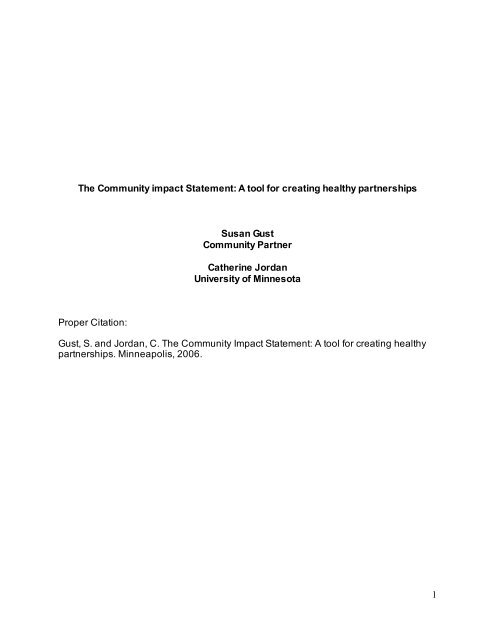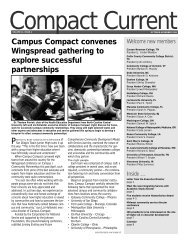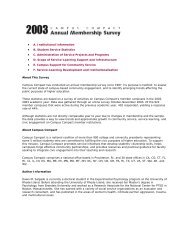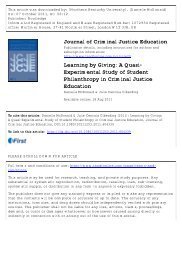1 The Community impact Statement: A tool for ... - Campus Compact
1 The Community impact Statement: A tool for ... - Campus Compact
1 The Community impact Statement: A tool for ... - Campus Compact
You also want an ePaper? Increase the reach of your titles
YUMPU automatically turns print PDFs into web optimized ePapers that Google loves.
<strong>The</strong> <strong>Community</strong> <strong>impact</strong> <strong>Statement</strong>: A <strong>tool</strong> <strong>for</strong> creating healthy partnershipsSusan Gust<strong>Community</strong> PartnerCatherine JordanUniversity of MinnesotaProper Citation:Gust, S. and Jordan, C. <strong>The</strong> <strong>Community</strong> Impact <strong>Statement</strong>: A <strong>tool</strong> <strong>for</strong> creating healthypartnerships. Minneapolis, 2006.1
II.III.IV.Making the Connections/Building the RelationshipsDoing the Work<strong>The</strong> Harvest: Evaluation/Dissemination/Policy Implications/Completion4
PREPARING THE GROUNDDiscussion Points <strong>for</strong> the Process of DevelopingA COMMUNITY IMPACT STATEMENTWhat is our history? How did we get here? Where did our idea to work togetheroriginate? Who were the individuals involved? Who approached who and why?What was the original idea or question that we came together to address? Do allmembers have a common understanding of our origins? Is this history shared fromtime to time? What does our project look like now? Is it an education, research orservice project?Commonalities and differences: What are the common goals that exist <strong>for</strong> comingtogether? What are the attributes that the partnership participants have in commone.g. being parents, caring <strong>for</strong> children, wanting to prevent a certain disease, etc. Whatare the differences that exist between the participants e.g. level of education, wherepeople live, employment status? What is at least one asset of each partnershipmember? <strong>The</strong>se can be items from being a firm but respectful timekeeper at a meetingto being a great scribe. What are the racial, class and cultural makeup of the meetinggoers? Who has and has not worked in that particular cultural group be<strong>for</strong>e?Logistics ground rules: Who calls the meetings? Where will the meetings be held andwhy? How often will meetings be held? Is there an individual, organization or outsideentity that is driving logistical decisions and is everyone com<strong>for</strong>table with this? Whowill set the agenda? How soon be<strong>for</strong>e the meeting will all meeting participants havethe agenda? What is the expectation around attendance? Who will take notes? Willnotes be distributed? What time of day will meeting be held and why? Is the meetingtime more convenient <strong>for</strong> some and less convenient <strong>for</strong> others? Will that affect thegroup in any way? Are there meeting provisions such as transportation, food, or daycare that would facilitate a broader spectrum of people being able to attend themeeting? How often might these logistical arrangements need to be reviewed so thatthere is full, equal and broad participation by as many people as necessary to theprocess?MAKING THE CONNECTIONS/BUILDING THE RELATIONSHIPSMeeting Ground Rules: Who will chair the meetings? Will the Chair get appointed orelected? How will decisions get made-consensus, Robert’s Rules of Order or a blendof both systems? Will there be training in how to effectively use these decision-makingprocesses? Will the entire group go through the training at the same time? Will thesedecisions be documented? Where will the documents be kept? Will they bereviewed? How often will the decision-making process be revisited to see that thegroup is still com<strong>for</strong>table with it? How will the group deal with “parking lot”conversations”? What are the other ground rules of the meetings, <strong>for</strong> example: use ofswear words, missing meetings, needing to request a change to the agenda, presenceof children, etc? Who is attending the meeting because it is “part of their job”, careerpath, educational goals, etc., and who is attending as a true volunteer? Is there or willthere be a tension between these different meeting attendance perspectives?5
Meeting Participants and Stakeholders: Who are the participants of the group? Arethey representing an organization or an institution? Are they consistent each month-----in other words, can an organization or institution send a different person each month?How do these participants report back to their organizations/institutions if they are todo so? Do they have a basic understanding of the parallel goals of the group todesign and implement a project and to build a model of shared power? Is there “buyin”?Are there stakeholders outside of the core partnership participants? Have theybeen identified? Has a clear communication strategy been established with thesestakeholders?Undoing Racism: Have individual members of the group participated in undoingracism workshops resulting in a power dynamic between those who have attendedsuch trainings and those who have not? In general, are there more white people inthe group than people of color? Has the group openly discussed theinstitutionalization of race and class discrimination and the effect of the issue of powerand privilege on the group?Self-Interest: Has each person declared what their individual self-interest inparticipating in the group is? Are some individual group members also representingan organization or institution that has a self-interest? If so, what is it?Shared Power: Has a power analysis been per<strong>for</strong>med by the group that goes beyondjust the aspect of who has more financial resources? Has each individual been askedto reflect upon their own personal power in the group and discussed the responsibilitythat comes with having power? Have all the issues of power and privilege---educationlevel, culture, class, institutional resources, acquired knowledge, etc.----been laid outon the table? What are the possible strategies or techniques with which the group canbe made com<strong>for</strong>table to attempt to equal the playing field so that power can beshared? Has a commitment been made to revisit this particular issue of “power” on atleast an annual basis? Are there any risks involved institutionally or within thecommunity with the idea of “sharing power”?DOING THE WORKMutual Benefits: What are the benefits to the university or higher education institution:implicit or clearly delineated as part of the project? Are these the same benefits thatthe community organizations or participants see as the benefits to the university?What are the benefits that the project will provide to the community? Are these thesame benefitsthat the community wants to receive from the work and the partnership? Do allconcerned agree to mutually work to providing these benefits <strong>for</strong> and with each other?How often will these lists of pursued mutual benefits be reviewed and perhaps,revised? Is there potential <strong>for</strong> risk of negative <strong>impact</strong>s on the community? Are thereany risks <strong>for</strong> those involved in working to provide these mutual benefits? How theserisks be prevented or minimized?Funding: Which person or entity will seek the funding? Do they have the capacity todo so or will their organizational capacity be increased by pursuing the funding? Howwill other members of the group support and assist them in this process? What will the6
accountability measures be to report on the funding procurement and theimplementation of the funding if received? Does money need to be raised <strong>for</strong> payingstipends? How is the money divided between the project partners? If not all of thefunding is received that is needed, is there a “plan B”? What will the potential <strong>impact</strong>of this be on the partnership? What was the process <strong>for</strong> making the funding decisionsand was the process documented so the partnership can reflect on this piece of historyin the future? Are there resource concessions or risks that some organizations have tomake to participate in the partnership and have they been identified? Has eachinstitution or organization laid out their own internal funding request approval processso that the group as a whole understands the implications and timeline? Will thepolicies of one institution need to be followed and, in effect, “trump” the policies ofother institutions or organizations participating in the project? Will the financialconstraints of community partners be adequately considered so that they may beeffectively engaged and sustained? How might the policies of the lead institution ororganization be met while meeting the needs of all of the partners involved?Institutional Review Board (IRB): Will there be a need to have the project reviewed byan IRB? What is the IRB’s familiarity with community-based, (not “placed”) projects?Is there an opportunity to have some advance dialogue with the IRB about the project?Is there an opportunity to establish a <strong>Community</strong> IRB? Has the issue of potential<strong>impact</strong> to an individual versus a community been examined so this piece can be partof the discussion with the IRB?Reporting to Other Stakeholders: Has time been built into the project timeline tocommunicate with the other stakeholders of the group? Have communicationstrategies been identified with those stakeholders?Timeline: What are the external timelines from the stakeholders or funding agenciesthat come to bear on the timeline of the community university partnership? What arethe expectations around time that each the community and university entities mayhave around time? Have major progress points or hallmarks been identified? Whereare the conflicts that might arrive around timeframe? How often do timeframes need tobe revisited? Whose job is it to see that these timeframe discussions occur?Hallmarks and Celebrations: Have major hallmarks or progress points been identifiedand communicated to partners so that these are mutually understood? What would begood methods of taking stock of the progress and celebrating it? Who needs to bepresent or invited <strong>for</strong> those celebrations in addition to the partnership members? Arethere progress reports made at these events, and, if so, in what <strong>for</strong>m are they made?How are the cultural components of the partnership reflected in the celebrations?Conflict and Conflict Resolution: If conflict helps to bring change, has the partnershipbeen introduced to this concept and embraced the notion that conflict will be anintegral part of the work? Has a <strong>for</strong>mal conflict resolution procedure been introducedand accepted by the partnership? What are the opportunities <strong>for</strong> training around theissues of conflict and conflict resolution?THE HARVEST: EVALUATION/DISSEMINATION/POLICY IMPLICATIONS/COMPLETION7
Evaluation: How will the project be evaluated? Who will do the evaluating, internal orexternal evaluator? Has the funds been raised to do this evaluation? What are thepossible funding entities <strong>for</strong> this evaluation? Who will write the proposals if it isdecided that grants will be pursued? Will all members of the partnership be able tofully participate in the evaluation-why or why not?Dissemination: Who will make decisions about how the data will be used? How willthese decisions be made? Where will the results of the work be disseminated? Whatwill be the <strong>for</strong>mat of those materials? How will the work of the partnership be sharedwith the community? What role will the community play in disseminating thosematerials? If journal articles are one of the ways that the materials are to bedisseminated, how will the community be acknowledged or credited? Are there otherways to share the materials beyond written <strong>for</strong>mats? How will the credit and the glory(if there is any) be shared? Will the community bring the academic institutionrepresentatives into the community to share the podium? How will the achievementsof all be hallmarked and celebrated?Policy Implications: Are there possible policy implications <strong>for</strong> this work? What arethey? How will possible policy makers, staff or organizations affected by futurepolicies be brought into this work and/or be in<strong>for</strong>med about the projects? Who willcarry the “torch” <strong>for</strong> doing so? What will the role of the higher ed institution be inthinking about the policy implications and the potential policy changes? Are there anyrisks involved?Completion: What happens when the project developed by the partnership iscompleted? Is the work of the partnership project-based or relationship-based? Isthere energy to make the partnership sustainable? Will this happen because that istruly what all of the participants want or is it just to difficult to say goodbye? If thepartnership becomes an ongoing entity, what will be gained and what will be lost?Have all of the accomplishments and the project completion noted, documentedand/or celebrated? If the partnership is not going to continue, has a graceful andrespectful “sunset” been planned and projected on the timeline?OTHER KEY ISSUES TO CONSIDER IN A COMMUNITY IMPACT STATEMENT:1. When is it just too late to consider embarking on a <strong>Community</strong> Impact <strong>Statement</strong>process?2. Should a natural sunset to the partnership be built in from the beginning orassessed along the way in order to decide if the partnership will become asustainable entity? How will the group know when the “end has come?” Howwill the partnership dissolve with grace and integrity?3. Are there other environmental, economic and/or sociological <strong>impact</strong>s that havenot been realized?4. How will documentation of the process be achieved?8
5. Are there risks to any of the individuals or organizations involved in thepartnership and have those been identified? For example, if a project is notcompleted on time, will a faculty person’s Promotion and Tenure be affected? Ifa grant is not received, will valuable community members have to be laid-off ordismissed from the project?6. What will the resulting covenant or agreement look like? Will it be an in<strong>for</strong>malagreement, written document such as a Memorandum of Understanding or amore legally binding document such as a contract?This set of guiding questions and process outline was conceived through the work ofthe Phillips Neighborhood Healthy Housing Collaborative (PNHHC), which existedfrom 1993 to 2003. <strong>The</strong> PNHHC conducted two federally-funded CBPR researchprojects during this time and also participated in community organizing, communityeducation, direct services around eliminating childhood lead poisoning in addition topublic policy change. This CIS process is based on the lessons learned and sharedexperiences between the Phillips community and University of Minnesota facultymembers. As a process, it has never been used or tested by a particular group, as faras we know.We are hopeful that this process may prove useful to community-universitypartnerships. However, we won’t know this to be true nor will we be able to makeimprovements or evaluate this proposed process unless we hear from you. Pleaseconsider giving us feedback about what you found most useful and how the CIS mightbe improved. Or, if you would like to discuss the possibility of helping to implementthis process in your community partnership, please contact us.Thank you <strong>for</strong> your consideration!Susan Gust, <strong>Community</strong> Partner612-724-5753 home/office612-724-4183 faxsgustsrc@aol.com2819 East 28 th StreetMpls., MN 55406Cathy Jordan, Director, Children, Youth and Families Consortium, University ofMinnesota9








